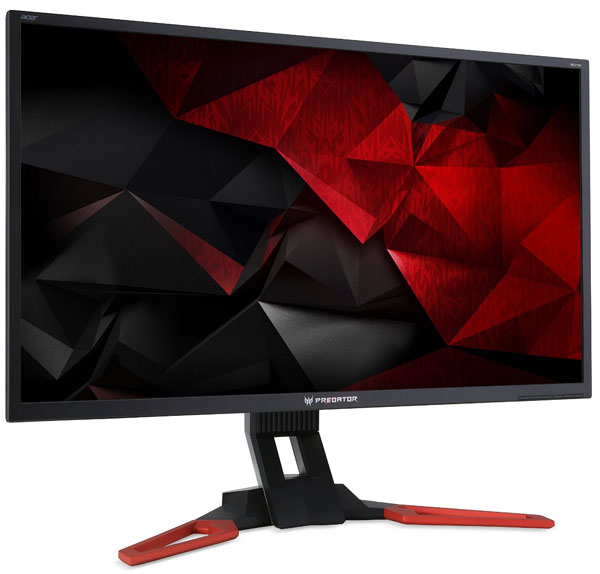Early Verdict
The Acer Predator XB321HK isn’t cheap but we think it’s worth every penny. It’s a flagship display that earns every bit of its title. Ultra HD gaming is still a challenge just because of the massive number of pixels that have to be moved. You’ll need an equally expensive system to realize its full potential, but if you have the means you won’t find better image quality anywhere.
Pros
- +
G-Sync
- +
Ultra HD
- +
32-inch IPS screen
- +
Clarity
- +
Vivid and accurate color
- +
Styling & build quality
Cons
- -
No swivel or portrait adjustment
- -
no DisplayPort 1.3
Why you can trust Tom's Hardware
Introduction
There’s no question that the top consideration on a monitor buyer's priority lists is price. Regardless of how much technology you want packed into your next purchase, value is always king. While that fact is apparent to anyone who reads through a few Internet forums, it hasn’t stopped every major manufacturer from creating and marketing a line of flagship products.
We’ve spent a fair amount of time working with different displays from Acer, and the company has produced some significant models including the very first Ultra HD panel with G-Sync, the XB280HK. We reviewed that screen last year and found it deserving of our Editor Recommended Award. It appears it will soon be replaced by the XB281HK from the Predator line. That series of products is where we’ll be focusing our attention today.
Recently we checked out the XB271HK which offers IPS, G-Sync and Ultra HD resolution in a 27-inch format. Now it’s time to see what makes Acer’s top-of-the-line gaming display tick. In our lab today we have the 32-inch Ultra HD XB321HK, also sporting an IPS panel and Nvidia G-Sync adaptive refresh technology.
Specifications
Even though TN panels offer good value and speed, users (and we) still prefer the superior viewing angles and more consistent quality of IPS displays. When resolutions reach 3840x2160 and screen sizes top 28 inches, it’s pretty much a requirement. Fortunately we haven’t seen a company attempt a TN product bigger than that.
The Predator XB321HK uses a panel from AU Optronics that delivers a full 32-inch diagonal viewing area. You may remember earlier UHD screens were actually 31.5 inches employing Sharp IGZO, Samsung and LG panels. This part also has a native 10-bit color depth along with an sRGB color gamut. Contrast levels at first glance appear to be on par with other IPS monitors of similar size and resolution.
The backlight is a white LED using constant-current for flicker-free operation. The G-Sync module is the same one that's used in the XB271HK. It's a second-generation part that adds HDMI to the input panel. It can handle 3840x2160 pixels at up to 30Hz but you’ll still have to use DisplayPort for adaptive refresh and the full 60Hz framerate. Claimed panel response is four milliseconds, and for those who plan to skip ahead to the lag tests, the XB321HK has fairly low latency when compared to other Ultra HD gaming displays.
The package is rounded out by the Predator line’s distinct styling and solid build quality. After unpacking it and powering up, our initial notes were filled with comments about its stunning image. Colors are bright and saturated; just what you’d expect from a premium-priced flagship product. Is the jumbo Predator worth its high cost? Let’s take a look.
Get Tom's Hardware's best news and in-depth reviews, straight to your inbox.
MORE: Best Computer Monitors
MORE: How To Choose A Monitor
MORE: Display Calibration 101
MORE: The Science Behind Tuning Your Monitor
MORE: All Monitor Content

Christian Eberle is a Contributing Editor for Tom's Hardware US. He's a veteran reviewer of A/V equipment, specializing in monitors. Christian began his obsession with tech when he built his first PC in 1991, a 286 running DOS 3.0 at a blazing 12MHz. In 2006, he undertook training from the Imaging Science Foundation in video calibration and testing and thus started a passion for precise imaging that persists to this day. He is also a professional musician with a degree from the New England Conservatory as a classical bassoonist which he used to good effect as a performer with the West Point Army Band from 1987 to 2013. He enjoys watching movies and listening to high-end audio in his custom-built home theater and can be seen riding trails near his home on a race-ready ICE VTX recumbent trike. Christian enjoys the endless summer in Florida where he lives with his wife and Chihuahua and plays with orchestras around the state.
